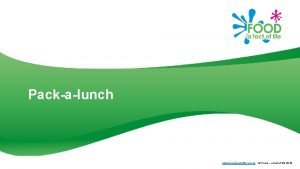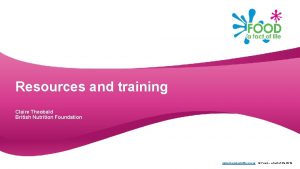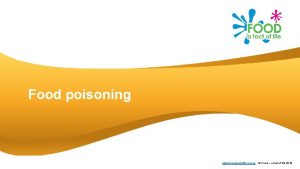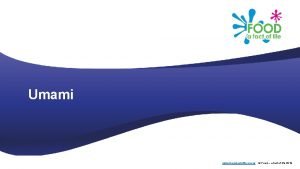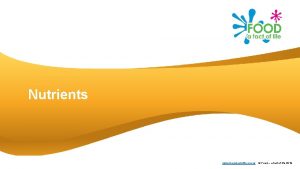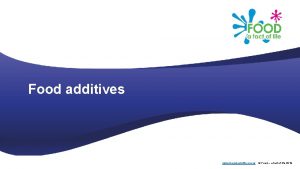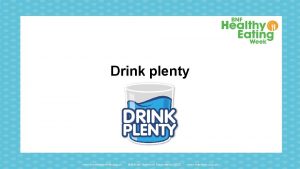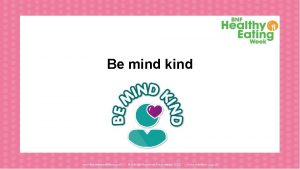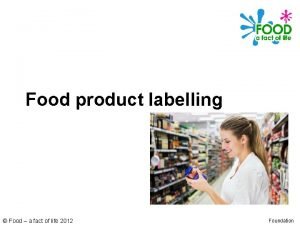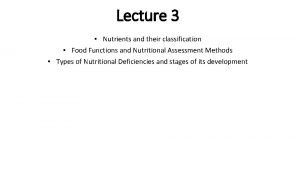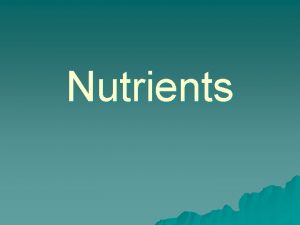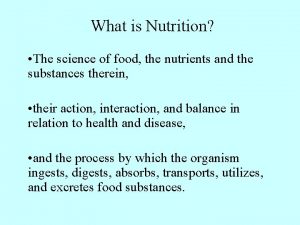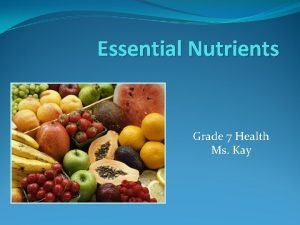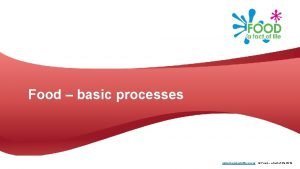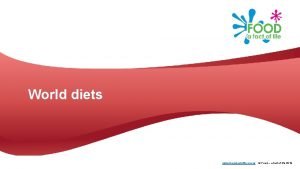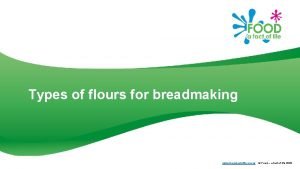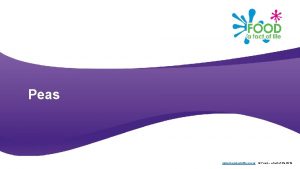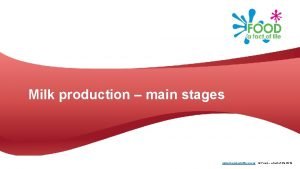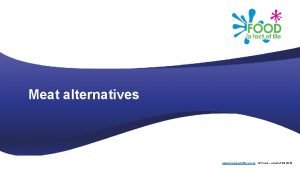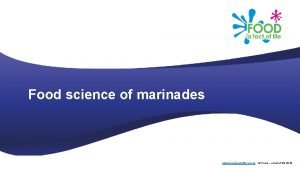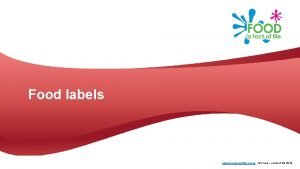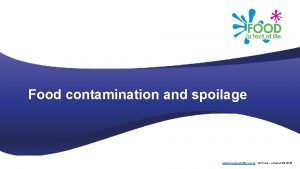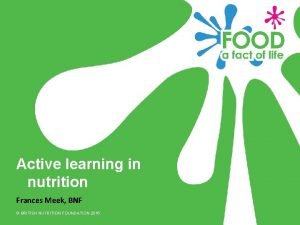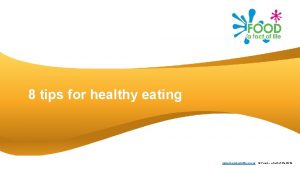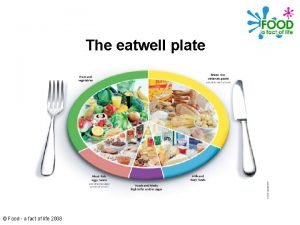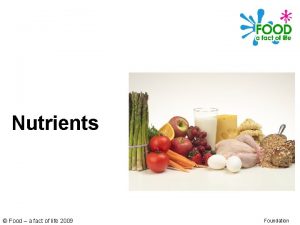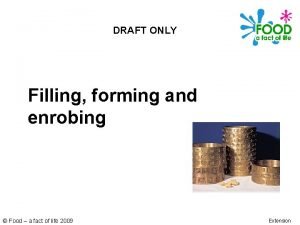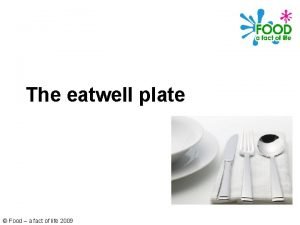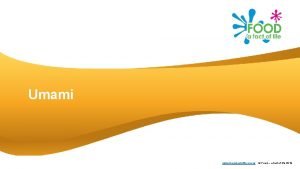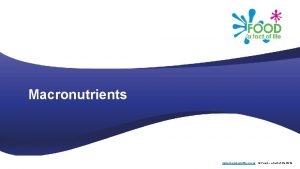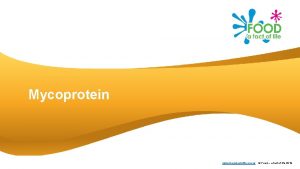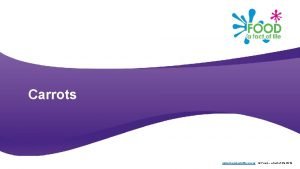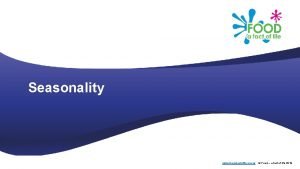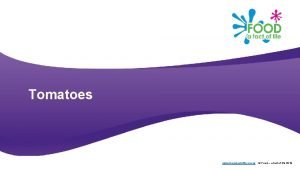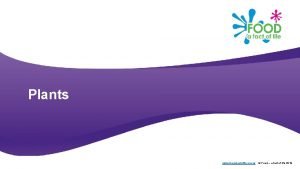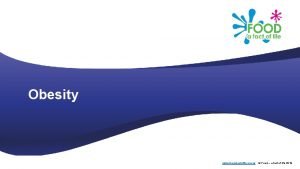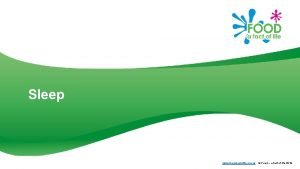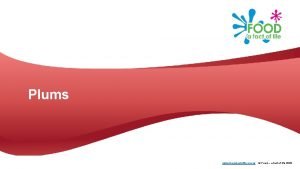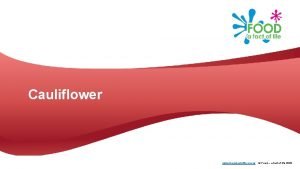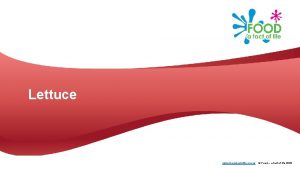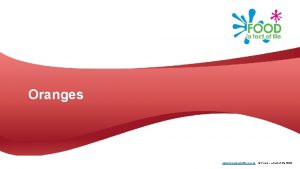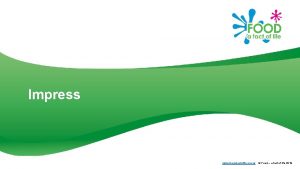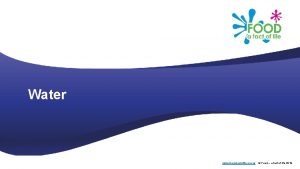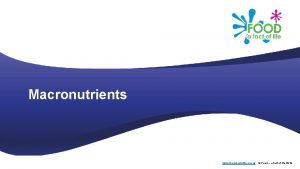Nutrients www foodafactoflife org uk Food a fact







































- Slides: 39

Nutrients www. foodafactoflife. org. uk © Food – a fact of life 2019

Nutrients Food is eaten and digested in the body to allow the absorption of energy and nutrients. There are two different types of nutrients: • macronutrients; • micronutrients. There are three macronutrients that are essential for health. These are: • carbohydrate; • protein; • fat. Macronutrients are measured in grams (g). www. foodafactoflife. org. uk © Food – a fact of life 2019

Carbohydrate The two main types of carbohydrate that provide dietary energy are starch and sugars. Dietary fibre is also a type of carbohydrate. Starchy carbohydrate is an important source of energy. One gram of carbohydrate provides 3. 75 kcal/16 k. J energy. One gram of fibre provides 2 kcal/8 k. J energy. www. foodafactoflife. org. uk © Food – a fact of life 2019

Structure of carbohydrate All types of carbohydrate are compounds of carbon, hydrogen and oxygen. They can be classified in many different ways. One common way is according to their structure. Sugars come from a variety of foods. Some are within the cellular structure of the food, e. g. in fruit or vegetables. These are called intrinsic sugars. Other sugars are not bound into the cellular structure of the food, e. g. in milk or honey. These are called extrinsic sugars. www. foodafactoflife. org. uk © Food – a fact of life 2019

Sources of sugar Can you give some examples of sources of sugar in the diet? • fruit and vegetables (fructose); • milk and dairy products (lactose); • honey; • fruit juice; • table sugar (sucrose); • sweets and chocolate. www. foodafactoflife. org. uk © Food – a fact of life 2019

Starchy carbohydrate Starch is found in a variety of foods. It is made up of many sugar molecules. Can you give some examples of sources of starch in the diet? • • Potatoes Bread Rice Pasta Cereal and cereal products are the main source of carbohydrate for adults in the UK. www. foodafactoflife. org. uk © Food – a fact of life 2019

Protein is essential for growth and repair and keeping cells healthy. Protein also provides energy: 1 gram of protein provides 4 kcal (17 k. J). www. foodafactoflife. org. uk © Food – a fact of life 2019

Structure of protein Protein is made up of building blocks called amino acids. Different foods contain different amounts and different combinations of amino acids. Protein from animal sources (e. g. meat, fish, eggs and dairy products) contains the full range of essential amino acids needed by the body. Protein from plant sources (e. g. pulses and cereals) typically contain fewer essential amino acids. www. foodafactoflife. org. uk © Food – a fact of life 2019

Sources of protein Animal: Plant: • meat; • nuts; • fish; • seeds; • eggs; • pulses, e. g. beans, lentils; • milk; • mycoprotein; • cheese. • soya products. www. foodafactoflife. org. uk © Food – a fact of life 2019

Protein sources Eating different types of protein can ensure sufficient intake of essential amino acids which are needed by the body. Name some examples of dishes which combine protein from different sources. For example: • Baked beans on wholegrain toast. • Breakfast cereal with milk. • Cottage pie with vegetables. • Hummus and salad wrap. • Fish pie and peas. • Spinach and chickpea curry with rice. www. foodafactoflife. org. uk © Food – a fact of life 2019

Fat provides fat-soluble vitamins A, D, E and K, and is necessary for their absorption. It is also important for essential fatty acids the body cannot make. Fat provides a concentrated source of energy: 1 gram of fat provides 9 kcal (37 k. J) of energy. Foods that contain a lot of fat provide a lot of energy. www. foodafactoflife. org. uk © Food – a fact of life 2019

Structure of fat Fat is made up of different types of fatty acids and glycerol. The structure of the fatty acids determines: • their effect on our health; • their characteristics, e. g. melting point. www. foodafactoflife. org. uk © Food – a fact of life 2019

Structure of fat Depending on their chemical structure, fatty acids are usually classified as: • saturated; • monounsaturated; • polyunsaturated. There is strong and consistent evidence that replacing saturated fatty acids with unsaturated fatty acids reduces the risk of CVD events and can help lower cholesterol. www. foodafactoflife. org. uk © Food – a fact of life 2019

Fatty acids All foods provide different types of fatty acids in varying proportions. Butter is often described as a ‘saturated fat’ because it has more saturated fatty acids than unsaturated fatty acids. Most vegetable oils are described as ‘unsaturated fats’ as they have more mono and polyunsaturated fatty acids than saturated. www. foodafactoflife. org. uk © Food – a fact of life 2019

Saturated and unsaturated fatty acids Most saturated fats are solid at room temperature and tend to come from animal sources. Some plant sources such as palm oil and coconut oil also have high levels of saturated fat. Most unsaturated fats are liquid at room temperature and are usually from plant sources. Oily fish is also high in long chain omega-3 fatty acids. www. foodafactoflife. org. uk © Food – a fact of life 2019

Micronutrients There are two types of micronutrients: • vitamins; • minerals. Vitamins and minerals are needed in much smaller amounts than macronutrients. Their amounts are measured in milligrams (mg) and micrograms (μg). (1 mg = 0. 001 g) (1μg = 0. 001 mg). www. foodafactoflife. org. uk © Food – a fact of life 2019

Vitamins There are two groups of vitamins: • fat-soluble vitamins, which can be stored in the body, e. g. vitamins A and D. • water-soluble vitamins, which cannot be stored in the body and are therefore required daily, e. g. B vitamins and vitamin C. www. foodafactoflife. org. uk © Food – a fact of life 2019

Fat soluble vitamins Vitamin A is needed for: • dim light vision; • healthy skin and eyes; • resistance to infection. Vitamin A is found pre-formed in liver and whole milk. It can also be produced from beta-carotene provided by dark green leafy vegetables, carrots and orange coloured fruit. In the UK, margarine must be fortified with vitamin A and vitamin D. Vitamin A and D are also often voluntarily added to reduced fat spreads. www. foodafactoflife. org. uk © Food – a fact of life 2019

Vitamin D is needed for the absorption of calcium from foods to keep bones and teeth healthy. A lack of vitamin D causes rickets in children, where the legs are bent, and osteomalacia in adults, which causes pain in bones and muscles. We get most of our vitamin D via the action of sunlight on skin during the summer months. Vitamin D is also provided by the diet from oily fish, meat, eggs, fortified breakfast cereals and margarine/spreads. www. foodafactoflife. org. uk © Food – a fact of life 2019

Water soluble vitamins There are many different B vitamins and each has a specific function in the body. These include: • vitamin B 1 (Thiamin); • vitamin B 2 (Riboflavin); • vitamin B 3 (Niacin); • vitamin B 6; • vitamin B 12; • folate/folic acid. www. foodafactoflife. org. uk © Food – a fact of life 2019

Thiamin (vitamin B 1) Thiamin is required to release energy from carbohydrate. It is also involved in the normal function of the nervous system. www. foodafactoflife. org. uk © Food – a fact of life 2019

Sources of Thiamin (vitamin B 1): • whole grains; • nuts; • meat (especially pork); • fruit and vegetables; • fortified breakfast cereals. Did you know? In the UK, white and brown bread flour are fortified with thiamin by law (and also with calcium, iron and niacin). www. foodafactoflife. org. uk © Food – a fact of life 2019

Riboflavin (vitamin B 2) Riboflavin is required to release energy from protein, carbohydrate and fat. It is also involved in the transport and use of iron in the body. www. foodafactoflife. org. uk © Food – a fact of life 2019

Sources of Riboflavin (vitamin B 2): • milk; • eggs; • rice; • fortified breakfast cereals; • liver; • legumes; • mushrooms; • green vegetables. Did you know? Legumes are the fruits or seeds of anything that comes in a pod, e. g. beans, peas, lentils. www. foodafactoflife. org. uk © Food – a fact of life 2019

Niacin (Vitamin B 3) Niacin is required for the release of energy from food. Niacin is also required for the normal function of the skin, mucous membranes and nervous system. Sources of Niacin: • meat; • wheat and maize flour; • eggs; • dairy products; • yeast. www. foodafactoflife. org. uk © Food – a fact of life 2019

Vitamin C is needed to make collagen. This is required for the structure and function of skin, cartilage and bones. It is an important nutrient for healing cuts and wounds. Did you know? Vitamin C can help with the absorption of iron when foods or drink containing both vitamin C and iron are eaten at the same meal. www. foodafactoflife. org. uk © Food – a fact of life 2019

Sources of vitamin C: • • • Fresh fruit especially citrus fruits and berries. Green vegetables. Peppers. Tomatoes. New potatoes. Can you name some citrus fruit? Lime, orange, grapefruit, tangerine, lemon, clementine. How many different types of berries can you think of? Blackberries, blackcurrants, strawberries, raspberries , blueberries, cranberries. www. foodafactoflife. org. uk © Food – a fact of life 2019

Minerals are inorganic substances required by the body in small amounts for a variety of different functions. The body requires different amounts of each mineral. People have different requirements, according to their: • age; • gender; • physiological state (e. g. pregnancy). www. foodafactoflife. org. uk © Food – a fact of life 2019

Calcium The body contains more calcium than any other mineral. It is essential for a number of important functions such as the maintenance of bones and teeth, blood clotting and normal muscle function. Did you know? The skeleton contains about 99% of the body’s calcium with approximately 1 kg present in adult bones. www. foodafactoflife. org. uk © Food – a fact of life 2019

Sources of calcium Milk, cheese and other dairy products provide about half of the calcium in the UK diet. Bread is also a source of calcium in the UK because white and brown flour is fortified with calcium by law. Calcium is also provided by: • broccoli; • cabbage; • fortified soya products; • fish eaten with the bones, e. g. sardines, tinned salmon and whitebait. www. foodafactoflife. org. uk © Food – a fact of life 2019

Iron is essential for the formation of haemoglobin in red blood cells. Red blood cells carry oxygen and transport it around the body. Iron is also required for the normal functioning of the immune system and in the reduction of tiredness and fatigue. Did you know? There are two types of iron; one from animals sources and the other from plant sources. www. foodafactoflife. org. uk © Food – a fact of life 2019

Sources of iron include: • • • Liver; Red meat; Pulses; Nuts; Eggs; Dried fruits; Fish; Whole grains; Dark green leafy vegetables. www. foodafactoflife. org. uk © Food – a fact of life 2019

Iron in the diet A lack of iron in the diet means that the stores in the body will run out. This can lead to anemia. Women and teenage girls need to ensure they have enough because their requirements are higher than those of men of the same age due to menstruation. Did you know? More than 2 billion people worldwide suffer from iron deficiency anaemia, making it the most common nutritional deficiency. www. foodafactoflife. org. uk © Food – a fact of life 2019

Sodium is found in all cells and body fluids. It is needed for regulating the amount of water and other substances in the body. Did you know? Sodium is a component of table salt, known as sodium chloride (Na. Cl). www. foodafactoflife. org. uk © Food – a fact of life 2019

Sources of sodium Most raw foods contain very small amounts of sodium chloride (salt). Salt is often added during the processing, preparation, preservation and serving of foods. About 20% of salt we eat is added at home during cooking and at the table. How can we reduce salt when preparing and cooking food? www. foodafactoflife. org. uk © Food – a fact of life 2019

Sodium in the diet Sodium intakes in the UK are considered to be too high. It is unlikely that we would lack sodium. High sodium intake is considered to be one of the risk factors for high blood pressure, which may lead to heart disease and stroke. Did you know? It is recommended that adults and children 11 years and over not to have more than 6 g of salt per day. Young children should eat less. www. foodafactoflife. org. uk © Food – a fact of life 2019

Summary Macronutrients include carbohydrate, protein and fat. These provide energy and are needed in large amounts. Micronutrients include vitamins and minerals. These do not provide energy but are essential for health. www. foodafactoflife. org. uk © Food – a fact of life 2019

Quiz - Kahoot • Open the link below on the main screen and get students to log onto kahoot. it on their tablets or smartphones. • They can then enter the code (that will come up on the main screen when you start the game) and their own nickname. • They can then play along with the quiz choosing the multiple choice answers that correspond with the questions on the main screen. There will then be a leaderboard of the scores after each question and at the end. https: //create. kahoot. it/share/nutrients/fb 67 ce 7 b-ce 4 b 46 fd-b 843 -5 b 3 d 026 e 0330 www. foodafactoflife. org. uk © Food – a fact of life 2019

Nutrients For further information, go to: www. foodafactoflife. org. uk © Food – a fact of life 2019
 Www.foodafactoflife.org.uk
Www.foodafactoflife.org.uk Explorefood.foodafactoflife.org.uk
Explorefood.foodafactoflife.org.uk Foodafactoflife
Foodafactoflife Www.foodafactoflife.org.uk
Www.foodafactoflife.org.uk Foodfactoflife
Foodfactoflife Www.foodafactoflife.org.uk
Www.foodafactoflife.org.uk Www.foodafactoflife.org.uk
Www.foodafactoflife.org.uk Www.foodafactoflife.org.uk
Www.foodafactoflife.org.uk Www.foodafactoflife.org.uk
Www.foodafactoflife.org.uk Food a fact of life
Food a fact of life Classification of nutrient
Classification of nutrient Nutrients are life-sustaining substances in food
Nutrients are life-sustaining substances in food The science of food the nutrients and substances therein
The science of food the nutrients and substances therein Food nutrients meaning
Food nutrients meaning Unit 2 food food food
Unit 2 food food food Food chain sequence
Food chain sequence Foodafactoflife costing a recipe
Foodafactoflife costing a recipe Food a fact of life costing a recipe
Food a fact of life costing a recipe Wacky warning labels
Wacky warning labels Foodafactforlife
Foodafactforlife Foodafactoflife
Foodafactoflife Foodafactoflife
Foodafactoflife Foodafactoflife
Foodafactoflife Foodafactoflife
Foodafactoflife Foodafactoflife
Foodafactoflife Food a fact of life
Food a fact of life Foodafactoflife
Foodafactoflife Foodafactoflife
Foodafactoflife Foodafactoflife calculator
Foodafactoflife calculator How does protease work
How does protease work Foodafactforlife
Foodafactforlife Www.foodafactoflife
Www.foodafactoflife Www.foodafactoflife
Www.foodafactoflife Frances meek
Frances meek Foodafactoflife
Foodafactoflife Food a fact of life sensory analysis
Food a fact of life sensory analysis What is it
What is it Food a fact of life
Food a fact of life What is enrobing in cooking
What is enrobing in cooking Composite foods
Composite foods
